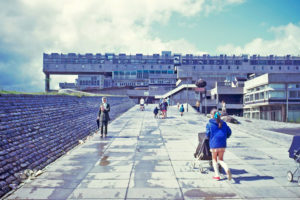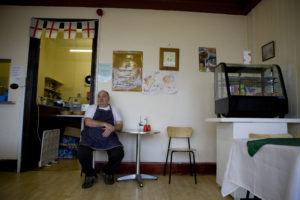Certain dance tunes never fail to take me back to the area I grew up in. Stirlingshire, in Central Scotland, is a county whose gloomy beauty and dramatic ruins have made it enduringly popular with tourists and retirees alike. In the Nineties the area was served by a number of small radio stations, which fed a stream of intoxicating rave music to teenagers living in the many corners of the region scarred by urban deprivation. Growing up in an era of fewer distractions, it felt like everyone you knew was phoning in, tuning in; that the music was a common bond.
Between 1971 and 1981 Stirlingshire suffered a massive reduction in manufacturing jobs, but it was the eradication of coal-mining in the mid-Eighties that sealed the fate of many communities. The boredom and hopelessness which had taken hold in the previous decade had, by the Nineties, curdled into a detachment among adolescents, which was manifesting itself in violent disorder, substance abuse and criminality. In this period, before the false dawn of Britpop and Cool Britannia, rave culture was dominant. Radio-friendly tunes such as Let Me Be Your Fantasy by Baby D and Set You Free by N-Trance rang out in back bedrooms and chip shops, and blared from hatchbacks that raced the quiet lanes and waste grounds that once served local industry.
The village of Fallin lies three miles beyond the tourist trails of the city of Stirling. As a pit village, the miners’ strikes and subsequent closures had a profound effect on the community. Sunk in 1904, the pits at Fallin — Polmaise Colliery 3&4 — were in operation until 1987. Coalfields were not profitable and did not reflect the ruling Conservative Party’s vision for Britain, and so they went. The closure of the Fallin pits stripped the village of its purpose and ended four centuries of coal-mining in Stirlingshire. The mine there had once been record breaking in both its militancy and productivity; it was the first to go on strike in 1984, and it stayed out the longest — 56 weeks. It topped productivity ratings, excavating 1,400 tons of coal a day in 1976, and once removed 20,000 tons in a week. The bonuses earned at Fallin caused such embarrassment for the rest of the industry that Union leaders had to request that the men slow down.
The community was thriving within a few years of the coal seam’s discovery, and it produced successive generations of instinctual, red-blooded workers who were inured to danger and fanatical about coal: young men who were conditioned physically, mentally and socially by the work. Far from today’s view of mining as a kind of occupation of last resort, the men and boys of the village chose the toil and discipline of the pit over anything else. John McCormack ran a hotel and won the Scottish Cup with Falkirk F.C. as a footballer; he was offered four times his mining wage to go professional, but nothing could stop him working underground. “Many a person in my position would have gone to work in the hotel full time”, he wrote in his memoir. “But I was a miner all my days, and I couldn’t get away from the pit.”
The colliery became not just the anchor point of village identity, but a special, albeit unmystical, space, inaccessible to outsiders, where husbands and uncles and brothers lived out the prime of their lives. Its underground shafts were a stage, where death was taunted with poetry and jokes, and where songs were sung under a low black ceiling that constantly creaked. It must have seemed inconceivable that the site to which the village owed its existence might disappear, but the shafts were sealed and the winding gear dismantled and, before 1987 was out, a dismal new era for Fallin began. Industrial estates sprang up offering minimum wage roles, and welfare-to-work schemes tried to capture the imaginations of men who had already had their heads turned by drink and drugs. Families stripped of their livelihoods, their optimism and the bonds of shared experience were soon being pulverised by heroin.
My high school classmates came from those families. The intergenerational trauma caused by addiction and poverty had had, in the decade since the closures, a profound effect on my school; there were at least four suicides in my year, including a hanging and a self-immolation, and a kind of adolescent ultra-violence was rife. Classes were dominated and disrupted by pupils, many from mining families, who were in complete rebellion against a society that had ceased to encourage ambition in their lives, and a curriculum which reflected nothing of the dysfunctional intensity of life outside the classroom. It has to be assumed that, given the opportunity, the young men may have become as fearsome and focused as their fathers and grandfathers once were, but they certainly weren’t mourning the loss of an imagined future. The collective imagination had already been seized by rave culture. Every bedroom I remember had its own devotional, Blu-tacked patchwork of spacey-looking rave flyers, covered in names of locally-famous role-model DJs who offered up simple, euphoric tunes that seemed to go straight to whatever it was that ailed you.
Is it possible to make a 16-year-old, fresh off a weekend of cheap stimulants and breakbeat hardcore, sit down on Monday morning and feel engaged or fulfilled by playing the theme from Steptoe & Son on a gut-string acoustic guitar? By piping meringues? By reading morality plays about people with moustaches? The kids of Fallin were travelling to enormous raves like Rezerection in Edinburgh, telling people they’d only just met that they loved them, forging their bonds above ground, in tents and fields. They were making money off drugs and burglary, racing banged-up Renaults under the moon, having casual sex in the woods that had begun to reclaim the rusting ruins of the pit machinery. Fallin was soon a warzone, scarred by graffiti, litter, fly tipping and dilapidation, and terrorised by youths whose energy couldn’t be harnessed by half-baked school and community initiatives which multiplied as uselessly as weeds.
This generation, whose parents had been told by Margaret Thatcher that there was “no such thing as society”, had the misfortune to hit their teens between the era of unionism and strong community their fathers had known, and the spread of the internet, which a decade later brought learning, friendship and lots of free entertainment to hollowed-out places like Fallin. In between they had to build their own networks; dance music on cassettes, phoned-in requests to radio stations, pool hall doorways and car meets in the dark. They responded to their abandonment with a single-mindedness that was no-doubt inherited, and an exuberance born of having nothing. It was a reclamation of sorts, full of undoubtedly violent and criminal behaviour, but perpetrated by characters for whom nothing existed but the immediate present, who had matured quickly and lived on their wits, who were smart, roguish, likeable and full of inimitable schemes and stories.
During the hardest times of the miners’ strikes, such was the solidarity that it felt as if Fallin — the housing stock, the community services, even the land itself — were under collective ownership of families who belonged to the village. But as successive generations grew up in a place without a purpose this solidarity fragmented quickly. For the new generation, which had become accustomed to unemployed role models, there were no positive shared values; they didn’t feel they had a stake in anything local. John McCormack, the miner footballer who observed the breakdown of the community, said: “The number one problem is work. The fortunes of the village were always tied up with the fortunes of the pit.”
McCormack was one of many miners still resident in Fallin who could remember a much less chaotic time. Mining stories too often leave out the cultural and social richness cultivated by miners; in Fallin, this richness revolved around the Gothenburg pub, so named because it ran on the Scandinavian system whereby the committee-run pub reinvested 95% of its profits in the local community. “The Goth” opened in 1910, and its profits helped build the village bowling club, fund a local pipe band, and hire a community nurse. Stars of the day, including Kathy Kirby, played at the miners’ social club. Supported by the mine, Fallin became a regional centre of achievement in dancing, football, athletics and dog racing. The Millhall Colliery Pipe Band became three-time World Champions, and no less than 34 world champions of one kind of another lived in Fallin in the inter-war years. One of these was Bob Starkey, a champion wrestler and Highland Games athlete, a coach at the Paris Olympics in 1924, a Policeman, a soldier and a miner at Polmaise Colliery. Starkey later modelled for the kilted and vested strongman on the Scott’s Porridge Oats box, an image that became emblematic of Scottish health and masculinity in the twentieth century.
Today mining has a different set of associations. Films, documentaries and works of literature have sought to portray the struggle of the miners’ strike, and that world — busses, soup kitchens, whipsmart wives, soggy-collared men waving placards in the rain — is ingrained on the British consciousness. But the impact of the mine closures went far beyond Thatcher and the miners and the families themselves, and the scale of the stories left untold is vast. Too often inhabitants of mining communities have been reduced to statistics by studies seeking to explore the negative consequences of pit closures: the health inequalities, social dislocation and unemployment, which were (and in some cases still are) rife in Stirlingshire and other areas where mining was once dominant. Far less has been written about how these communities prospered, how they kept going through a poverty that was enforced on them, the strength they found in music and culture, their humour, their warmth, their wisdom. In the case of Fallin, how a young village, sunk in one short decade, began to right itself.
In July 1988 the Stirling Central Regional Council opted for full clearance of the Polmaise Colliery site, to, “eradicate all traces of this failed industry”. The Goth still stands, having recently funded a defibrillator for the village, but of the pit itself only the bing — the huge mound of spoil accumulated during the mining process – is visible today. While there have been a number of suicides here, it has been successfully rebranded as “Fallin and Polmaise wood”, a nature reserve managed by the Woodland Trust. A small stone cairn was unveiled to mark where the shafts once were, and a memorial dedicated to miners who had lost their lives was installed in 1994. A memorial garden with some old pieces of machinery was opened in 2006. Numerous organisations have helped Fallin recover from the disorder of the Nineties, including Fallin Community Enterprises, a charity established in 2005 which aims to drive forward the social, economic and environmental regeneration of the village. It was unthinkable 30 years ago that anyone would want to move to Fallin, but the village continues to grow. In 2021, 400 new houses were approved for land to the East, but despite a 25% affordable housing requirement, it’s unlikely any of them will be within the budget of former mining families in the area.
Driving through on a recent Saturday evening the energy and turbulence is gone. A recent study described Fallin as a “non-place”, and at a glance it is hard to argue. Beyond the grey and brown houses, there’s nothing here: a row of half-shut shops, a flat-roofed library, a Tesco Express. It remains an austere village with no real centre. Some progress is evident — 72% of residents own at least one car, 33% have a degree — but below the surface are the same old community concerns. In May of last year residents of Fallin were asked what they felt the priority should be in any further regeneration of the village. Older respondents focussed on activities for young people (74%). The priority for younger respondents was school (67%) and they also mentioned things to do (64%). One respondent noted, “the people are our greatest asset”.
The new housing developments are bringing young families to the village, and the youth of Fallin today, raised on the same distractions as everyone else, are indoors — rightly unhaunted by the legacies of coal. Out on the streets, compared to the Fallin of 30 years ago the place looks nearly welcoming; some waste ground remains, but the graffiti and syringes are gone. Derelict sites have been converted to green spaces and sports facilities. On residential streets the hedges are square, the creosote fresh, SUVs are parked up at regular intervals. Looking up at the windows it’s hard not to wonder if any of the voices that could be heard requesting tunes on the radio all those years ago might be living here now, prospering somehow, with their own young ones. The odd hatchback whizzes past but the windows are up, the speed limit is observed. Rave seems about as relevant here as Kathy Kirby. There’s no music blaring anywhere.
Disclaimer
Some of the posts we share are controversial and we do not necessarily agree with them in the whole extend. Sometimes we agree with the content or part of it but we do not agree with the narration or language. Nevertheless we find them somehow interesting, valuable and/or informative or we share them, because we strongly believe in freedom of speech, free press and journalism. We strongly encourage you to have a critical approach to all the content, do your own research and analysis to build your own opinion.
We would be glad to have your feedback.
Source: UnHerd Read the original article here: https://unherd.com




